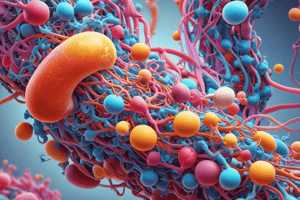Podcast
Questions and Answers
What is the primary location of fatty acid oxidation in cells?
What is the primary location of fatty acid oxidation in cells?
- Endoplasmic reticulum
- Nucleus
- Golgi apparatus
- Mitochondria (correct)
What is the other name for fatty acid oxidation?
What is the other name for fatty acid oxidation?
- Lipogenesis
- Glycolysis
- Gluconeogenesis
- Beta-oxidation (correct)
What molecule is attached to fatty acids during the activation step of fatty acid oxidation?
What molecule is attached to fatty acids during the activation step of fatty acid oxidation?
- Glucose
- Glycerol
- Coenzyme A (CoA) (correct)
- Insulin
In what part of the cell does the activation of fatty acids occur?
In what part of the cell does the activation of fatty acids occur?
What key molecule facilitates the transport of acyl-CoA into the mitochondria?
What key molecule facilitates the transport of acyl-CoA into the mitochondria?
What is produced during each cycle of beta-oxidation?
What is produced during each cycle of beta-oxidation?
What molecule is formed from fatty acid oxidation that then enters the citric acid cycle?
What molecule is formed from fatty acid oxidation that then enters the citric acid cycle?
Which hormone inhibits ketogenesis?
Which hormone inhibits ketogenesis?
Under what conditions is ketogenesis upregulated?
Under what conditions is ketogenesis upregulated?
What is the term for the physiological state characterized by elevated levels of ketone bodies in the blood?
What is the term for the physiological state characterized by elevated levels of ketone bodies in the blood?
What is a potentially life-threatening condition caused by uncontrolled ketogenesis?
What is a potentially life-threatening condition caused by uncontrolled ketogenesis?
Which of the following is NOT a primary ketone body?
Which of the following is NOT a primary ketone body?
What is the term for the process by which ketone bodies are converted back into acetyl-CoA in extrahepatic tissues?
What is the term for the process by which ketone bodies are converted back into acetyl-CoA in extrahepatic tissues?
Which type of cholesterol is often referred to as 'good' cholesterol?
Which type of cholesterol is often referred to as 'good' cholesterol?
What is the function of HDL cholesterol?
What is the function of HDL cholesterol?
What is the major function of LDL cholesterol?
What is the major function of LDL cholesterol?
Elevated levels of which lipid are linked to insulin resistance and metabolic syndrome?
Elevated levels of which lipid are linked to insulin resistance and metabolic syndrome?
Which of the following is a genetic disorder characterized by high LDL cholesterol levels from birth?
Which of the following is a genetic disorder characterized by high LDL cholesterol levels from birth?
Which of the following is a broad term referring to elevated levels of lipids in the blood?
Which of the following is a broad term referring to elevated levels of lipids in the blood?
What is the term for imbalances in lipid levels, such as elevated LDL cholesterol or low HDL cholesterol?
What is the term for imbalances in lipid levels, such as elevated LDL cholesterol or low HDL cholesterol?
Flashcards
Fatty Acid Oxidation
Fatty Acid Oxidation
Process by which fatty acids are broken down to generate energy, primarily in the mitochondria.
Activation of Fatty Acids
Activation of Fatty Acids
Fatty acids are activated in the cytoplasm by attaching a coenzyme A (CoA) molecule, forming acyl-CoA, requiring ATP.
Transport into Mitochondria
Transport into Mitochondria
Acyl-CoA molecules are transported into the mitochondria via the carnitine shuttle system.
Beta-Oxidation
Beta-Oxidation
Signup and view all the flashcards
Ketone Bodies
Ketone Bodies
Signup and view all the flashcards
Ketogenesis
Ketogenesis
Signup and view all the flashcards
Ketolysis
Ketolysis
Signup and view all the flashcards
Ketosis
Ketosis
Signup and view all the flashcards
Ketoacidosis
Ketoacidosis
Signup and view all the flashcards
Lipid Profile
Lipid Profile
Signup and view all the flashcards
Total Cholesterol
Total Cholesterol
Signup and view all the flashcards
Triglycerides
Triglycerides
Signup and view all the flashcards
High-Density Lipoprotein (HDL) Cholesterol
High-Density Lipoprotein (HDL) Cholesterol
Signup and view all the flashcards
Low-Density Lipoprotein (LDL) Cholesterol
Low-Density Lipoprotein (LDL) Cholesterol
Signup and view all the flashcards
Hyperlipidemia
Hyperlipidemia
Signup and view all the flashcards
Dyslipidemia
Dyslipidemia
Signup and view all the flashcards
Familial Hypercholesterolemia
Familial Hypercholesterolemia
Signup and view all the flashcards
Hypertriglyceridemia
Hypertriglyceridemia
Signup and view all the flashcards
Study Notes
Fatty Acid Oxidation (Beta-Oxidation)
- Fatty acid oxidation, also known as beta-oxidation, breaks down fatty acids to generate energy.
- This metabolic pathway primarily occurs in the mitochondria of cells, especially in tissues like the liver, muscle, and adipose tissue.
- Fatty acids need activation before oxidation, a process in the cytoplasm.
- Activation involves attaching coenzyme A (CoA) to a fatty acid, forming acyl-CoA and requiring ATP.
- Acyl-CoA molecules must be transported into the mitochondria for beta-oxidation using the carnitine shuttle system.
- Within mitochondria, fatty acids undergo enzymatic reactions called beta-oxidation.
- Each beta-oxidation cycle cleaves a two-carbon unit from the fatty acid chain.
- The products of beta-oxidation include acetyl-CoA, NADH, and FADH2.
- These products enter the citric acid cycle (Krebs cycle) to generate ATP through oxidative phosphorylation.
- Acetyl-CoA from fatty acid oxidation enters the citric acid cycle for further oxidation, producing additional NADH and FADH2.
- Electron carriers donate electrons to the electron transport chain, leading to ATP production.
- Regulation of fatty acid oxidation involves hormone signals, substrate availability, and the cell's energy needs.
- Enzymes in beta-oxidation are subject to allosteric and hormonal control.
- Understanding fatty acid oxidation is essential for comprehending metabolic disorders like FAODs, resulting from defects in enzymes or transport proteins in the pathway.
- FAODs can manifest as hypoglycemia, muscle weakness, and cardiomyopathy.
Ketone Bodies
- Ketone bodies are water-soluble molecules produced by the liver from fatty acids during prolonged fasting, low carbohydrate intake, or untreated diabetes mellitus.
- The three primary ketone bodies: acetoacetate, beta-hydroxybutyrate, and acetone.
- Ketogenesis happens in the liver mitochondria.
- It involves converting acetyl-CoA (from fatty acid oxidation) into ketone bodies.
- Ketogenesis is upregulated by low insulin and high glucagon levels, indicating a need for alternative fuel sources.
- Ketone bodies are transported from the liver to extrahepatic tissues, such as muscle and brain.
- These tissues convert ketone bodies back into acetyl-CoA through ketolysis.
- Acetyl-CoA from ketone bodies can enter the citric acid cycle to produce ATP.
- Ketone body production is regulated by hormonal and metabolic factors.
- Insulin inhibits ketogenesis, while glucagon and cortisol stimulate it.
- The availability of fatty acids also affects the rate of ketone body production.
- Ketone bodies act as an alternative fuel source, especially for the brain during glucose scarcity.
- They cross the blood-brain barrier allowing neurons to oxidize them to generate ATP, preserving glucose for essential functions.
- Ketosis indicates elevated ketone bodies in the blood.
- It occurs during fasting or low-carbohydrate diets.
- Uncontrolled ketogenesis leads to ketoacidosis.
- Ketoacidosis is a life-threatening condition with high ketone levels, metabolic acidosis, and dehydration, often seen in untreated type 1 diabetes mellitus.
- Understanding ketone body metabolism is crucial for managing conditions such as diabetes mellitus
- Abnormalities in carbohydrate and lipid metabolism can lead to dysregulated ketone production and metabolic complications.
Lipid Profile and Disorders
- The lipid profile blood test measures: total cholesterol, triglycerides, high-density lipoprotein (HDL) cholesterol, and low-density lipoprotein (LDL) cholesterol.
- Total cholesterol represents all cholesterol in lipoproteins circulating in blood.
- Elevated total cholesterol increases the risk of atherosclerosis and cardiovascular disease.
- Triglycerides are fats in the blood, derived from dietary intake and liver synthesis.
- High triglyceride levels (hypertriglyceridemia) is linked to obesity, insulin resistance, metabolic syndrome, and cardiovascular disease risk.
- HDL cholesterol helps remove excess cholesterol from the bloodstream and transports it to the liver for excretion.
- Higher HDL cholesterol levels is associated with a reduced risk of cardiovascular disease.
- LDL cholesterol is a major carrier of cholesterol in the blood.
- Elevated LDL cholesterol contributes to atherosclerosis, increasing the risk of heart disease and stroke.
- Disorders in lipid profile is characterized by abnormalities in lipid metabolism:
- Hyperlipidemia refers to elevated lipids in the blood, including cholesterol and triglycerides, which is a risk factor for cardiovascular disease.
- Dyslipidemia is imbalances in lipid levels, such as elevated LDL, low HDL, or high triglycerides, and is associated with metabolic disorders like obesity, diabetes, and metabolic syndrome.
- Familial Hypercholesterolemia is a genetic disorder causing high LDL cholesterol from birth, leading to premature atherosclerosis and increased cardiovascular risk.
- Hypertriglyceridemia involves elevated triglyceride levels from genetic factors, dietary habits, obesity, insulin resistance, or medical conditions.
- Managing lipid profile disorders involves lifestyle modifications, pharmacotherapy (lipid-lowering medications), and addressing underlying metabolic conditions to reduce cardiovascular risk and improve overall health.
Studying That Suits You
Use AI to generate personalized quizzes and flashcards to suit your learning preferences.



